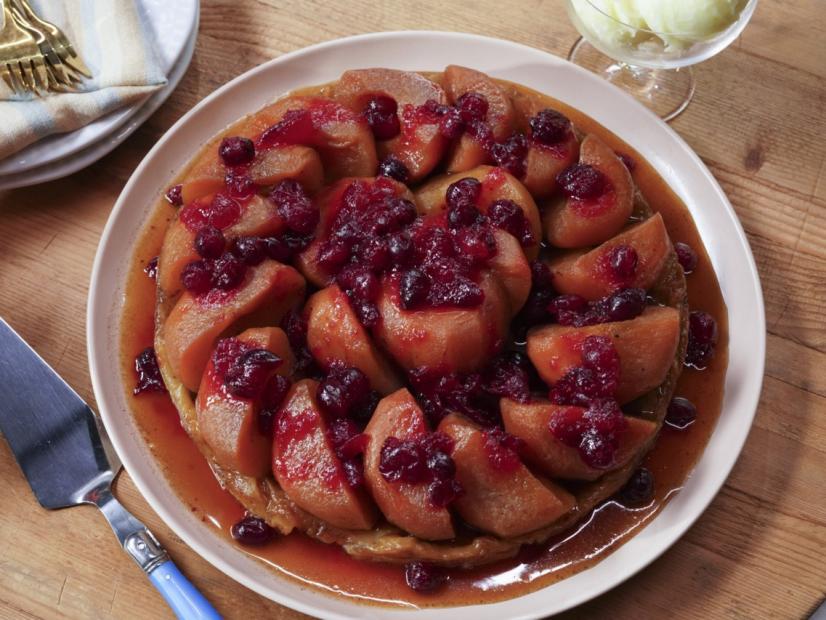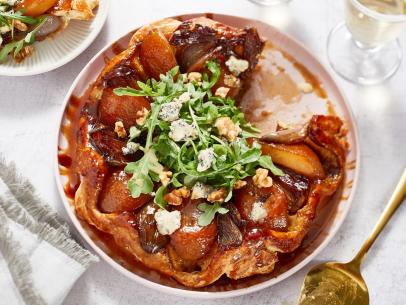
- Level: Intermediate
- Total: 1 hr 55 min (includes cooling time)
- Active: 30 min
- Yield: 8 to 10 servings
-
- Nutritional Analysis
- Per Serving
- Serving Size
- 1 of 10 servings
- Calories
- 389
- Total Fat
- 2 g
- Saturated Fat
- 1 g
- Carbohydrates
- 88 g
- Dietary Fiber
- 10 g
- Sugar
- 68 g
- Protein
- 2 g
- Cholesterol
- 3 mg
- Sodium
- 11 mg
According to French culinary lore, one of the Tatin sisters dropped an apple tart on the floor and served it as it landed—in other words, upside down with the fruit on top! (I even read in one book that the tart fell down a flight of stairs.) An unlikely story, but I agree that accidents in the kitchen can lead to magnificent classic dishes like this. Apples always get so much love and the spotlight; it is the iconic fruit to use here, so feel free to sub in Granny Smith, Rome or Braeburn apples. If you know me at all, I am forever championing pears, and they can often be found firm and slightly underripe, which is good for this dessert. Mushy, fully ripe pears need not apply here. I like Anjou or Bartlett for their reliable (and usually non-mealy) texture. Forelle pears are great if you want to double the amount and use these mini pears for added drama. For puff pastry, buy a frozen (square/rectangular) sheet larger than the pan. You can also use a few layers of phyllo brushed with butter in its place. All utensils and the skillet have to be clean for this recipe, or the caramel can become fussy and grainy. Resist the urge to stir the caramel as it cooks. Just watch it as it melts and caramelizes. Also: be careful, caramel is VERY simple to make but also VERY hot to handle.
- Level: Intermediate
- Total: 1 hr 55 min (includes cooling time)
- Active: 30 min
- Yield: 8 to 10 servings
-
- Nutritional Analysis
- Per Serving
- Serving Size
- 1 of 10 servings
- Calories
- 389
- Total Fat
- 2 g
- Saturated Fat
- 1 g
- Carbohydrates
- 88 g
- Dietary Fiber
- 10 g
- Sugar
- 68 g
- Protein
- 2 g
- Cholesterol
- 3 mg
- Sodium
- 11 mg
Ingredients
Tarte:
Cranberry Caramel:
Directions
- For the tarte: Preheat the oven to 400 degrees F.
- Heat a CLEAN 10-inch cast-iron skillet and add the sugar and 3 tablespoons water. Cook gently over medium-low heat until the sugar melts and turns golden brown, 10 to 12 minutes. (Do not stir the caramel. Just gently swirl the skillet.) Remove the skillet from the heat and begin arranging the pear halves in a circular shape around the borders of the skillet. Fill the center part of the skillet with a smaller circle of pears. Fill in any gaps with the smaller top and bottom pieces. Because the fruit will shrink considerably as it cooks, it is better to crowd the skillet with fruit.
- Place the skillet on the heat again and, with the heat relatively low so the caramel doesn’t burn, cook until the fruit starts to soak up the caramel at the bottom, around 20 minutes. Roll the puff pastry sheet up on a rolling pin like a parchment scroll and unroll it back over right on top of the pears. Tuck the dough edges inside the skillet so it covers the fruit completely. (It is as if you are tucking the fruit into a pastry bed.) Cut three 2-inch slits in the puff pastry.
- Place the skillet in the center of the oven and bake until the pastry browns and the fruit is tender when pierced with the tip of a knife, 40 to 45 minutes. Remove the skillet from the oven and cool for only 10 to 15 minutes, as it unmolds more easily when hot. Pour the excess caramel into a bowl by tilting the skillet, and reserve it. Place a platter over the pastry topping and flip the tarte onto the platter. Pour the caramel back over the tarte. If any fruit remains in the bottom of the skillet, simply dislodge and insert it in any fruit gaps before serving. Serve with lemon sorbet or classic vanilla ice cream.
- For the cranberry caramel: In a large skillet, warm the butter and cranberries. Cook 1 to 2 minutes, then add the brandy and flame it to cook off most of the alcohol. Add the sugar, vinegar and 1 cup water and cook over high heat until the cranberries burst and the liquid thickens, 5 to 8 minutes. Cool for at least 30 minutes or up to 45. It will thicken further as it cools. Pour over the tarte just before serving.
- Disclaimer: Use extreme caution when igniting alcohol. Remove the pan from the heat source before adding the alcohol. Pour the alcohol into the pan and carefully ignite with a match or click lighter. Return the pan to the heat and gently swirl to reduce the flames.
































